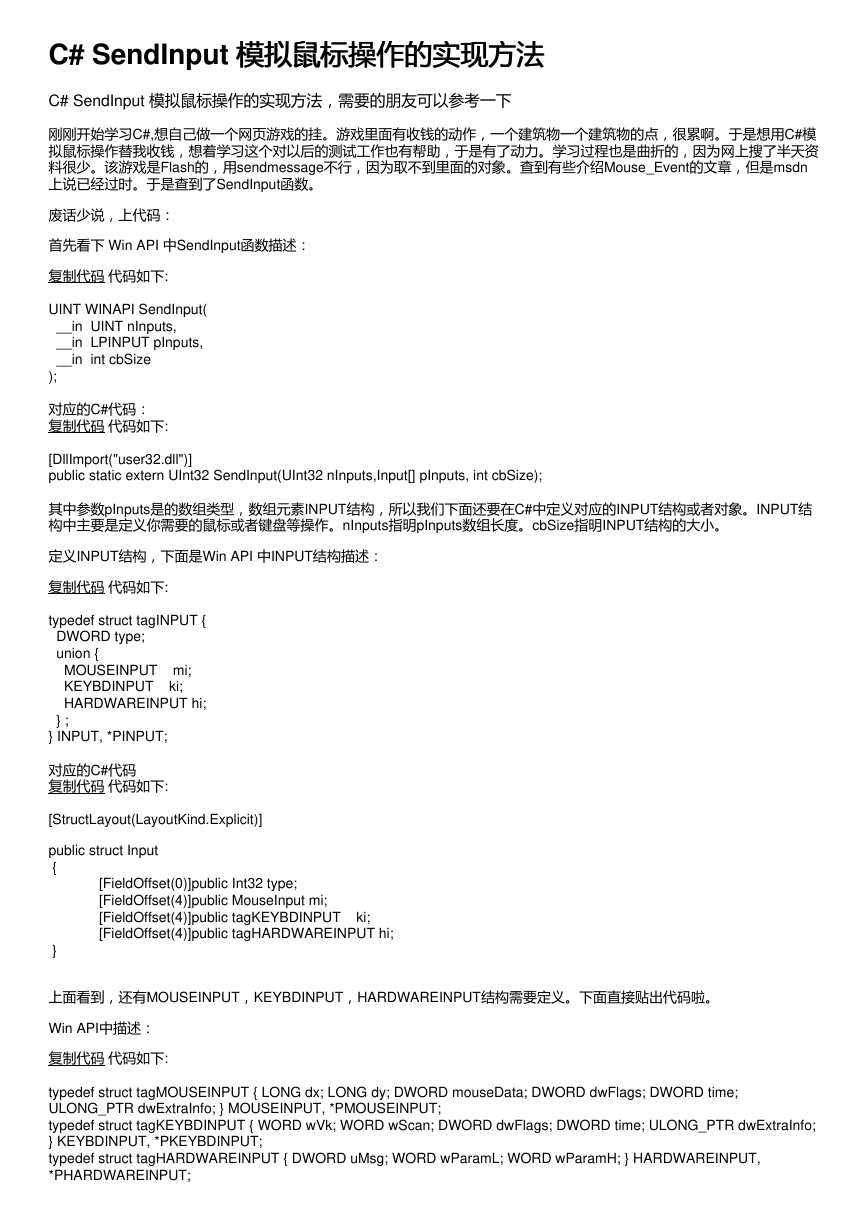C# SendInput 模拟鼠标操作的实现方法
模拟鼠标操作的实现方法
C# SendInput 模拟鼠标操作的实现方法,需要的朋友可以参考一下
刚刚开始学习C#,想自己做一个网页游戏的挂。游戏里面有收钱的动作,一个建筑物一个建筑物的点,很累啊。于是想用C#模
拟鼠标操作替我收钱,想着学习这个对以后的测试工作也有帮助,于是有了动力。学习过程也是曲折的,因为网上搜了半天资
料很少。该游戏是Flash的,用sendmessage不行,因为取不到里面的对象。查到有些介绍Mouse_Event的文章,但是msdn
上说已经过时。于是查到了SendInput函数。
废话少说,上代码:
首先看下 Win API 中SendInput函数描述:
复制代码 代码如下:
UINT WINAPI SendInput(
__in UINT nInputs,
__in LPINPUT pInputs,
__in int cbSize
);
对应的C#代码:
复制代码 代码如下:
[DllImport("user32.dll")]
public static extern UInt32 SendInput(UInt32 nInputs,Input[] pInputs, int cbSize);
其中参数pInputs是的数组类型,数组元素INPUT结构,所以我们下面还要在C#中定义对应的INPUT结构或者对象。INPUT结
构中主要是定义你需要的鼠标或者键盘等操作。nInputs指明pInputs数组长度。cbSize指明INPUT结构的大小。
定义INPUT结构,下面是Win API 中INPUT结构描述:
复制代码 代码如下:
typedef struct tagINPUT {
DWORD type;
union {
MOUSEINPUT mi;
KEYBDINPUT ki;
HARDWAREINPUT hi;
} ;
} INPUT, *PINPUT;
对应的C#代码
复制代码 代码如下:
[StructLayout(LayoutKind.Explicit)]
public struct Input
{
[FieldOffset(0)]public Int32 type;
[FieldOffset(4)]public MouseInput mi;
[FieldOffset(4)]public tagKEYBDINPUT ki;
[FieldOffset(4)]public tagHARDWAREINPUT hi;
}
上面看到,还有MOUSEINPUT,KEYBDINPUT,HARDWAREINPUT结构需要定义。下面直接贴出代码啦。
Win API中描述:
复制代码 代码如下:
typedef struct tagMOUSEINPUT { LONG dx; LONG dy; DWORD mouseData; DWORD dwFlags; DWORD time;
ULONG_PTR dwExtraInfo; } MOUSEINPUT, *PMOUSEINPUT;
typedef struct tagKEYBDINPUT { WORD wVk; WORD wScan; DWORD dwFlags; DWORD time; ULONG_PTR dwExtraInfo;
} KEYBDINPUT, *PKEYBDINPUT;
typedef struct tagHARDWAREINPUT { DWORD uMsg; WORD wParamL; WORD wParamH; } HARDWAREINPUT,
*PHARDWAREINPUT;
�
C#中对应代码:
复制代码 代码如下:
[StructLayout(LayoutKind.Sequential)]
public struct MouseInput
{
public Int32 dx;
public Int32 dy;
public Int32 Mousedata;
public Int32 dwFlag;
public Int32 time;
public IntPtr dwExtraInfo;
}
[StructLayout(LayoutKind.Sequential)]
public struct tagKEYBDINPUT
{
Int16 wVk;
Int16 wScan;
Int32 dwFlags;
Int32 time;
IntPtr dwExtraInfo;
}
[StructLayout(LayoutKind.Sequential)]
public struct tagHARDWAREINPUT
{
Int32 uMsg;
Int16 wParamL;
Int16 wParamH;
}
我主要是模拟鼠标,所以只需定义鼠标的flag值:
复制代码 代码如下:
const int MouseEvent_Absolute = 0x8000;
const int MouserEvent_Hwheel = 0x01000;
const int MouseEvent_Move = 0x0001;
const int MouseEvent_Move_noCoalesce = 0x2000;
const int MouseEvent_LeftDown = 0x0002;
const int MouseEvent_LeftUp = 0x0004;
const int MouseEvent_MiddleDown = 0x0020;
const int MouseEvent_MiddleUp = 0x0040;
const int MouseEvent_RightDown = 0x0008;
const int MouseEvent_RightUp = 0x0010;
const int MouseEvent_Wheel = 0x0800;
const int MousseEvent_XUp = 0x0100;
const int MousseEvent_XDown = 0x0080;
c#中模拟鼠标操作的代码:
复制代码 代码如下:
for (i = X; i <= X+width; i += 450)
//X为Flash窗口的左上角的x轴绝对坐标值。屏幕左上角坐标是(0,0)。width是Flash窗口宽度。
{
for (j = Y; j <= Y +height; j+=150) //Y为Flash窗口的左上角的y轴绝对坐标值。height是Flash窗口高度。
{
MouseInput myMinput = new MouseInput();
myMinput.dx = i;
myMinput.dy = j;
myMinput.Mousedata = //www.jb51.net/cx361/archive/2011/12/11/0;
myMinput.dwFlag = MouseEvent_Absolute | MouseEvent_Move | MouseEvent_LeftDown |
MouseEvent_LeftUp;
�
myMinput.time = 0;
Input[] myInput = new Input[1];
myInput[0] = new Input();
myInput[0].type = 0;
myInput[0].mi = myMinput;
UInt32 result = SendInput((uint)myInput.Length, myInput, Marshal.SizeOf(myInput[0].GetType()));
if (result == 0)
{
MessageBox.Show("fail");
}
}
}
知识点:将像素坐标转化为绝对坐标:
API中MouseInput结构中的dx,dy含义是绝对坐标,是相对屏幕的而言的,屏幕左上角的坐标为(0,0),右下角的坐标为
(65535,65535)。而我们在C#中获得的对象(Frame,button,flash等)的坐标都是像素坐标,是跟你当前屏幕的分辨率相
关的。假如你的显示器分辨率是1024*768,那么屏幕左上角的像素坐标是(0,0),右下角坐标为(1024,768)。转换函数如
下:
复制代码 代码如下:
dx = x * (65335/ScreenWidth) //x,y为像素坐标。
dy = y * (65335/ScreenHeight)//ScreenWidth和ScreenHeight,其实是当前显示器的分辨率,获得方法是
ScreenWidth=Screen.PrimaryScreen.WorkingArea.Width;
ScreenHeight=Screen.PrimaryScreen.WorkingArea.Height;
�






 2023年江西萍乡中考道德与法治真题及答案.doc
2023年江西萍乡中考道德与法治真题及答案.doc 2012年重庆南川中考生物真题及答案.doc
2012年重庆南川中考生物真题及答案.doc 2013年江西师范大学地理学综合及文艺理论基础考研真题.doc
2013年江西师范大学地理学综合及文艺理论基础考研真题.doc 2020年四川甘孜小升初语文真题及答案I卷.doc
2020年四川甘孜小升初语文真题及答案I卷.doc 2020年注册岩土工程师专业基础考试真题及答案.doc
2020年注册岩土工程师专业基础考试真题及答案.doc 2023-2024学年福建省厦门市九年级上学期数学月考试题及答案.doc
2023-2024学年福建省厦门市九年级上学期数学月考试题及答案.doc 2021-2022学年辽宁省沈阳市大东区九年级上学期语文期末试题及答案.doc
2021-2022学年辽宁省沈阳市大东区九年级上学期语文期末试题及答案.doc 2022-2023学年北京东城区初三第一学期物理期末试卷及答案.doc
2022-2023学年北京东城区初三第一学期物理期末试卷及答案.doc 2018上半年江西教师资格初中地理学科知识与教学能力真题及答案.doc
2018上半年江西教师资格初中地理学科知识与教学能力真题及答案.doc 2012年河北国家公务员申论考试真题及答案-省级.doc
2012年河北国家公务员申论考试真题及答案-省级.doc 2020-2021学年江苏省扬州市江都区邵樊片九年级上学期数学第一次质量检测试题及答案.doc
2020-2021学年江苏省扬州市江都区邵樊片九年级上学期数学第一次质量检测试题及答案.doc 2022下半年黑龙江教师资格证中学综合素质真题及答案.doc
2022下半年黑龙江教师资格证中学综合素质真题及答案.doc